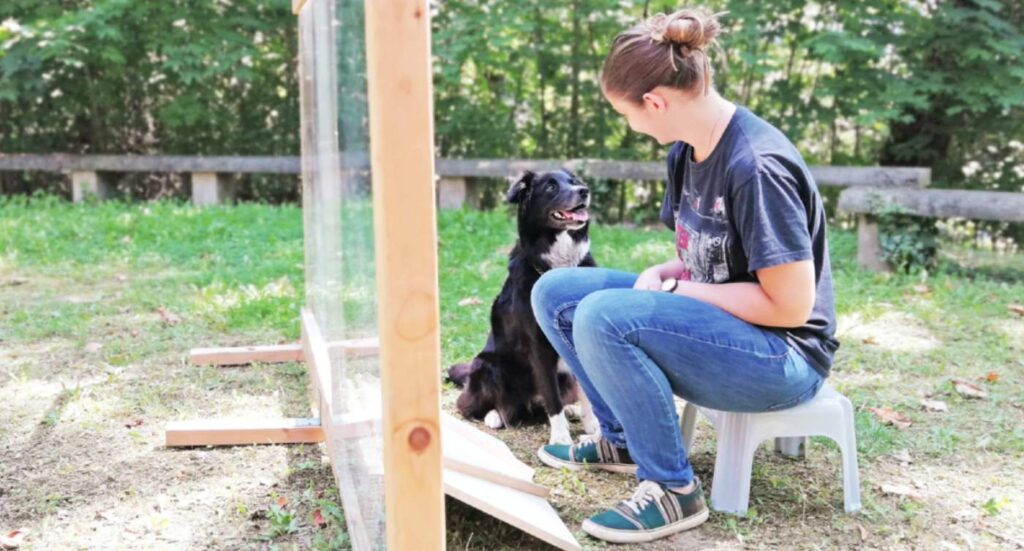
Dogs can tell the difference between deliberate actions—and mistakes, say scientists.
It adds growing evidence to the idea that man’s best friend knows just how we are feeling.
First author Dr Britta Schunemann said, “The dogs in our study clearly behaved differently depending on whether the actions of a human experimenter were intentional or unintentional.”
Dogs have bonded with people over thousands of years. Obeying every “sit,” “lay down,” and “roll over” command is just one such skill.
But whether they understand intentions, or merely respond to outcomes, remains unclear.
This is a basic component of Theory of Mind—long regarded as uniquely human.
It’s the ability to attribute mental states to oneself and others and dogs have it too.
They can tell the difference between something done on purpose, or by accident.
Dr Schunemann, of Gottingen University, and colleagues tested how they reacted when food rewards were withheld.
The researchers found the animals behaved differently depending on whether the actions of the experimenter were intentional or unintentional.
It shows dogs can distinguish between actions that were done on purpose, or accidentally.
To reach their conclusions, the German team conducted an experiment using the ‘unable vs. unwilling’ paradigm.
It works by examining whether test subjects react differently towards a human experimenter.
They either intentionally (the unwilling condition) or unintentionally (the unable condition) withhold treats.
The experiment was conducted with 51 dogs, each of which was tested under three conditions.
Each animal was separated from the human tester by a transparent barrier. It was fed pieces of dog food through a gap.
In the ‘unwilling’ condition, the experimenter suddenly withdrew the reward through the gap in the barrier and placed it in front of herself.
In the ‘unable-clumsy’ condition, the experimenter brought the reward to the gap and ‘tried’ to pass it through—but then ‘accidentally’ dropped it.
In the “unable-blocked” condition, the experimenter again tried to give the dog a reward.
But she was unable to because the gap was blocked. In all conditions, the reward remained on the tester’s side of the barrier.
Co-author Dr Juliane Brauer, of Max Planck Institute for the Science of Human History, said, “If dogs are indeed able to ascribe intention-in-action to humans we would expect them to show different reactions in the unwilling condition compared to the two unable conditions. As it turns out, this is exactly what we observed.”
The primary behaviour measured by the researchers was the time dogs waited before approaching the reward they were denied.
If dogs are able to identify human intentions, they would wait longer before approaching the reward in the unwilling condition, where they were not supposed to have the reward, than in the two unable conditions in which the reward was, in fact, meant for them.
MORE: Clever Cockatoos Craft 3-Piece Tool Set to Extract Fruit – Becoming Only 4th Animal Species to Do So
Not only did the dogs wait longer in the unwilling condition than in the unable conditions, they were also more likely to sit or lie down—actions often interpreted as appeasing behaviours—and stop wagging their tails.
Co-author Dr Hannes Rakoczy, also from Gottingen, said, “This suggests dogs may indeed be able to identify humans’ intention-in-action.”
The findings in Scientific Reports suggest dogs “may have at least one aspect of Theory of Mind—the capacity to recognize intention-in-action,” said the researchers.
Previous studies have found dogs can tell the difference between happy and angry faces.
They also process language in a very similar way to humans—picking out emotional tone, intonation, and volume changes that influence meaning.
LOOK: Devious Dog Fakes a Coma to Avoid Toilet Duty in the Rain –And it’s So Cute (WATCH)
Experts think dogs have gradually evolved over 30,000 years to understand humans.
Selective breeding has meant those which could communicate better with their owners were preferred, encouraging the trait to become more pronounced over time.
RAISE Your Paws For This Fascinating Research by Sharing…




















